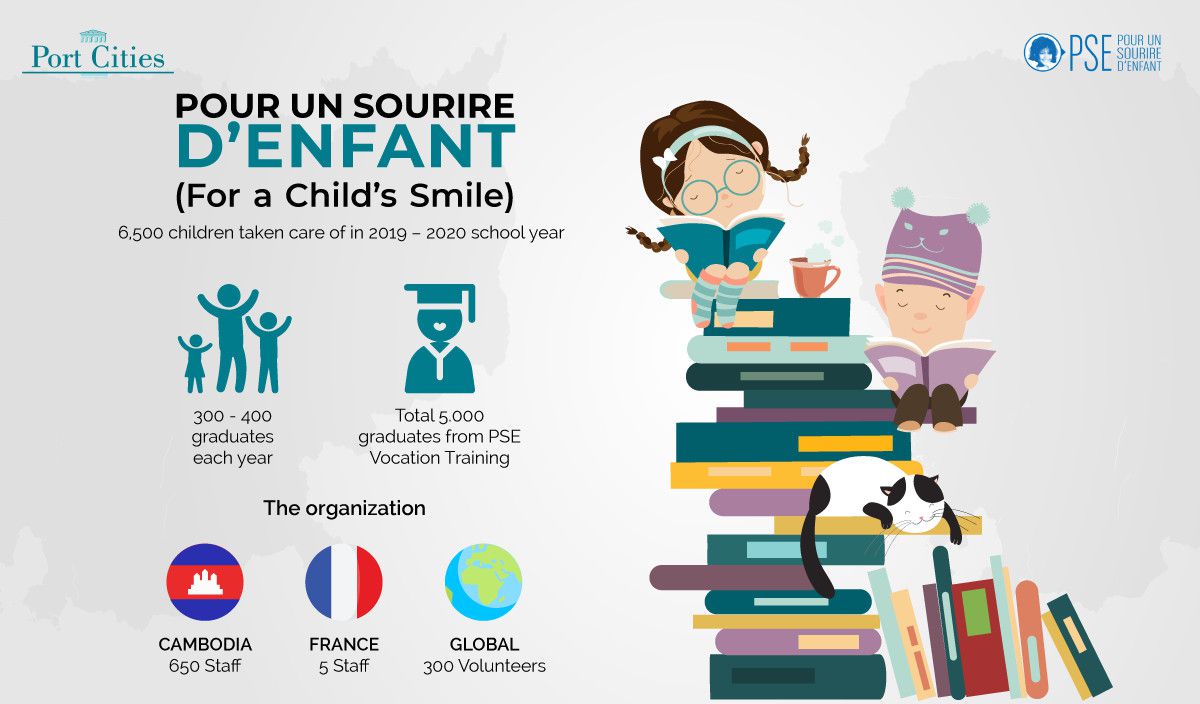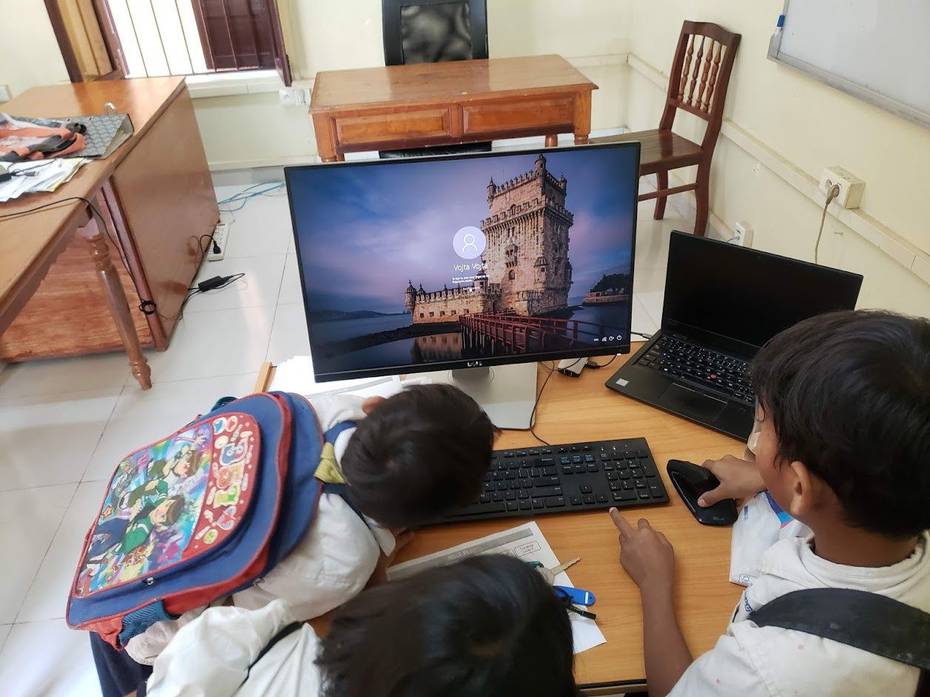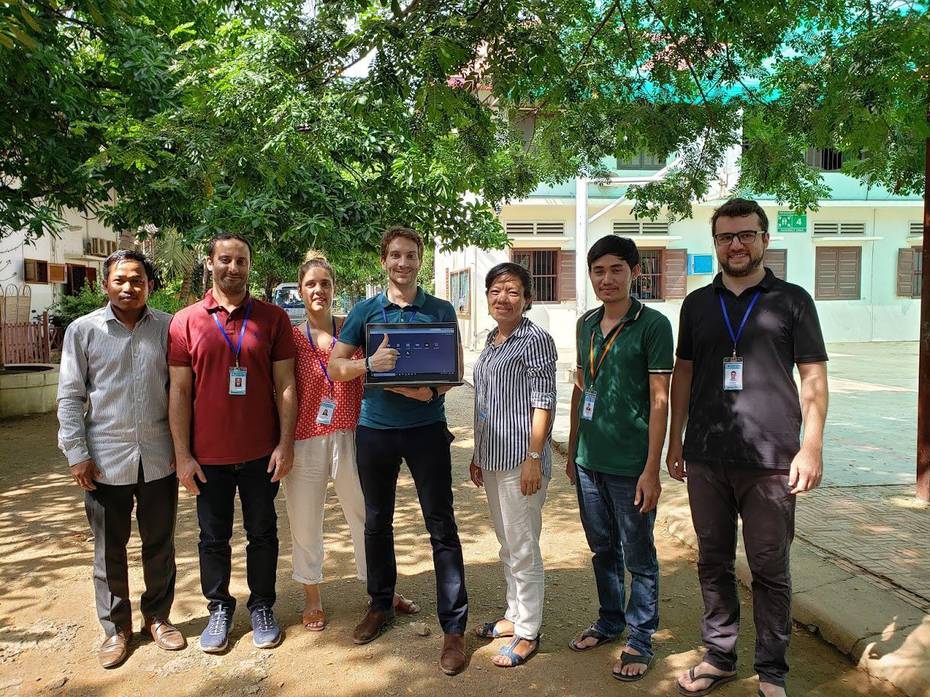
Location: Cambodia, France, Global
Industry: NGO
Number of Odoo Users: 120
Company Size: Large
Time of Implementation: 1 year
Modules Implemented: Accounting, Purchase, Point of Sales, Inventory, Invoicing, Expenses.
Pour un Sourire d'Enfant (PSE) – For a Child's Smile is a French non-profit organization founded in 1995 by Christian and Marie-France des Pallières, who decided to take action after witnessing the horrors of poverty on the children of war-torn Cambodia. The organization is tasked with an important humanitarian mission: to help thousands of Cambodian children escape destitution by providing them with adequate healthcare, education and vocational training so they can ultimately become independent members of society.
Port Cities interviewed Mr. Clement Muris, Consultant to the General Director of PSE and Vojtech Krotky, Director of Port Cities Vietnam who was also the Senior Project Manager and Lead Analyst of the project. Let’s dive in and learn how PSE was able to use Odoo to strengthen administration and provide support to over 6500 at-risk children in Cambodia.
1. Can you briefly tell us about the organization?
Mr. Muris: Pour un Sourire d’Enfant (PSE) – For a Child’s Smile - is a French non-profit organization operating in Cambodia under an MOU with the Ministry of Foreign Affairs since 1995. PSE’s mission is to help children suffering acute hardship by reintegrating them into society and by creating a safe and appropriate environment for them to study and to learn a trade that is as highly qualified as possible. Recognized by the local authorities, PSE is working with full respect for the country of Cambodia, with the Cambodians, and thus supports the sustainable development of the nation.
PSE operates six main programs that meet children’s needs, allowing a key-integrated approach for the success of its action: nutrition, healthcare, protection and accommodation, general education, vocational training and family support.
For the school year 2019-2020, PSE is taking care of more than 6,500 children in its various programs. 300 to 400 Students graduate from PSE Institute each year. Today, a total of 5,000 graduates from the PSE Vocational Training program have successfully integrated the job market with a real qualified position. They live with dignity and provide support for their family.
PSE employs around 650 Cambodian people and 5 staff in France. 300 volunteers from various countries actively promote the organization and raise funds through donations and sponsorships.

In 2000, PSE was awarded the French Human Rights Prize by the French Republic.
In 2021, PSE founder was decorated as Commander of the National Order of Merit by the French Ambassador in Cambodia.
2. Did you use any information system before Odoo?
Mr. Muris: Before Odoo, we were using individual standalone systems including a simple Accounting system (CIEL) with limited functionalities and basic accounting features. an HR system. We also used a standard POS system for our non-profit restaurant, hotel, gift shop, and other vocation training facilities.
Mr. Krotky: Before adopting an all-in-one ERP system, it is common for clients to use various standalone information systems and Excel sheets for specific business departments which are supposed to be interconnected such as procurement and accounting, with complicated paperwork and approval processes.
Having information stored in such separate systems can lead to loss or duplication of data, and eventually difficulties in consolidating different data sets, thus not allowing efficient reporting. Thís problem can simply be addressed with a correctly implemented ERP system, which stores all data in one place.
3. What were the main motivations and expectations toward the new ERP system?
Mr. Muris: The Accounting system vendor we were using stopped providing support and maintenance. Therefore, with this project, we aimed to not only replace the old accounting system but take this initiative to modernize the financial department and equip our staff with a tool that can provide more functionalities and expand the scope of operation of the department.
We did not have a computerized system for purchasing workflow: everything was done on paper forms and invoices, which made it difficult to look up information, analyze procurement activities, and make business decisions. So the idea was to digitize the paperwork process in the Purchase function as well. An automated Purchase process would help us make fewer manual entry mistakes in creating Purchase orders, eliminate the need for manual signatures, reduce wait time during approvals, thus making the process smoother and more efficient. As a result of having all purchase information in one system, we would have complete visibility and can aggregate analysis over our activities.
With the new ERP system, we also aimed to improve stock management, of which the main stock is a large amount of rice (average 8 tons each week) distributed to 1,600 families on a weekly basis.
Previously, all of our data was stored in complicated Excel spreadsheets and each department had a different format of data entry, stock-in-and-out was registered manually. An automated inventory management system would help us reduce errors during manual entry and prevent loss of data.
Most importantly, with Odoo, we expected to streamline intra-departmental processes with integrated modules that connect all the processes mentioned above. Instead of having 4 people in different departments entering the same information in various stages of the process, this data now only needs to be entered only once in the beginning and is linked to all involved departments who can see the information.
Thanks to the integrated ERP system that helps reduce a significant amount of paperwork and manual entry, we can better allocate our human resources. Our staff volunteers can focus on more important responsibilities which add value to our humanitarian mission.— Mr. Clement Muris, Consultant to the General Director of PSE.
Mr. Krotky: The ERP is only as strong as the organization's processes and workflows. As a result, the natural first step in this implementation was to understand PSE’s accounting & procurement processes, then reengineering and automating them. PSE brought the knowledge of their processes and their requirements, while Port Cities brought the ERP expertise and best operational practices. Success in ERP implementation is about finding a common ground between these two.
Our primary goal was to digitize the full E2E workflow - to eliminate paper documentation - and we kept this in mind throughout the entire system design, ensuring that all of these flows were confirmed and tested during thorough E2E testings internally and with PSE end-users.
For example, an approval process previously involved hard-copy paper being passed through up to 5 people, now can be performed digitally in just a few clicks. Or if you had to look for an old transaction, the old practice was you would have to go to an archive room full of paper documents and look for the hard copy; now this information can be found in just a few clicks on Odoo.
During implementation, we must always find the sweet spot - keeping the business process owners and end-users involved as early as possible to kick-start change management in the organization, and combining it with know-how and best industry practices.

4. What made you decide to choose Odoo to be your main ERP software and Port Cities to be the implementation partner?
Mr. Muris: The IT team of PSE did extensive research on ERP service providers in the region (Asia). We were open to a variety of ERP options such as Odoo, Microsoft Dynamics, Oracle, SAP, and other ERP implementation partners, including two Odoo Partners.
Out of 10 proposals we received, Port Cities’ proposal was one of the most well-structured, with serious intent and accurately addressed all the challenges we were trying to solve with a new ERP.
In the second step, we met and did a demo with 3 shortlisted ERP implementation partners. We had the best impression with Odoo which seemed to be very flexible, user-friendly, and easy to use even for people with limited computer literacy. It is especially adaptable and customizable to specific business needs, whereas other systems appeared to be more resistant to changes or adjustments.
Another advantage of Odoo was its price point, which is very affordable compared to other products. With Odoo, we perceived lower financial risks and higher ROI due to a very transparent and fair license cost structure calculated on a per-user basis.
As for Port Cities, they demonstrated experience and expertise in previous client projects in the region and they provided us with a more realistic implementation timeline and projections. Given the size of both companies, we were confident that they would be able to provide a level of customer support and care that went beyond a simple business partnership. Most importantly, they were able to send key team members onsite in Cambodia for the duration of the project, which was critical to the project's success.
Mr. Krotky: It is always appreciated when the client has clear expectations & requirements, and is available to discuss with us the vision of the system as well as our understanding of the as-is state, as was exactly the case of PSE - always willing to clarify details, during an online or in-person meeting.
It is also important to keep it in mind, in case a bigger ERP implementation is expected (thousands of hours), the initial analysis, the understanding of the client´s context, and project planning will also take more time than it would for a 50 man-day long implementation.
Do you need information on how we implement Odoo ERP?

5. What modules were implemented or customized? What departments were involved in the new changes?
Mr. Muris: We implemented Accounting, Inventory, Purchase Orders (PO) and a fully customized Purchase Request module.
Mr. Krotky: PSE, as a non-profit organization is subject to different audit regulations and stricter approval rules than many other for-profit businesses. We always kept that in mind and worked together to come up with an optimal solution that will allow an easy approval flow and transparent audit trail for expenses such as purchase requests, purchase orders, inventory moves, and tendering among others.
Transparent reporting is critical for PSE and all stakeholders because they must inform donors about how donations are being spent, whether on overhead, financial aids for at-risk people to pay their rent, operating their vocational training centers, or distributing rice and necessities to underprivileged Khmer families. Each social program run by PSE has an approved budget, and they must closely monitor expenditures. Every single expense needed to be accounted for and assigned to the appropriate department for the correct purposes.
6. How important do you think it is to have a good analysis and understand business requirements and processes before implementation?
Mr. Muris: The important first step is for the client to submit a detailed request for proposal (RFP) outlining exactly what functionalities are required in the new system. This allows the ERP implementation partner to provide more accurate responses for recommended solutions.
We implemented Purchase and Stock Management in the first phase, remodeled the Finance team in the second phase, and deployed the POS system six months later.
The whole implementation went very smoothly with Port Cities team members directly working onsite, understanding how things are operated internally, and meeting the end-users of the system.
Users initially had difficulty visualizing how the manual process would be transformed digitally. Therefore it is essential to have a prototype that could help users imagine and define their own needs and for Port Cities to develop and test features based on these needs.
What we could have improved is to go even more agile in terms of development method which means each small feature is developed, tested, and adjusted, allowing the flexibility of the system to be put into play.
Mr. Krotky: The most critical factor to the success of the project is having a good business analysis, which can take different forms, either through a detailed RFP, or on-site presence and discussion of the as-is/to-be state which can last several days before the kick-off of the implementation.
In the case of PSE, we proposed splitting the project into two phases rather than doing everything at once in order to focus our attention on fewer things at a time. Implementation in phases helped us identify what should be prioritized and perfect the development of each feature one by one.

What functionalities do you need in your ERP system?
7. Did Port Cities deliver the project within budget and timeline?
Mr. Muris: Yes they were able to deliver the project completely within the agreed budget and timeline.
Mr. Krotky: Yes, our implementation & cooperation were successful also because of very clearly set expectations & mutual respect between PSE and Port Cities. Because, after all, the success behind ERP implementation is always shared between both sides - the client & service provider.
During the implementation, we bore in mind the common goal - and all our discussions were focused on how to achieve it together, within the agreed timeline & budget, even if it meant we needed to adjust some requirement or accept the slightly different implementation approach & methodology.
8. How was the communication between you and the PCV team during implementation?
Mr. Muris: Communication between PSE and Port Cities was very easy, especially with members of Port Cities working onsite.
Having members of the Port Cities team on-site throughout the whole process facilitated communication and accelerated the pace of collaboration in identifying specific challenges and designing/testing a solution on the Odoo system.
Mr. Krotky: In any collaboration, we strive to establish a well-defined communication process, including weekly project meetings to update progress and solve any bottlenecks, as well as monthly steering committee meetings with project sponsors. It is really important to have support from the top management. In the event of any changes, we escalate the process and consult with relevant stakeholders, ensuring that everyone is on the same page & that the right decisions are made, on time.
Communication is key in any cooperation. In fact, one of the main reasons why ERP implementations often fail is insufficient communication between the service provider and the client. In cooperation, it is about finding the compromise between cost and benefits. If the client understands this, success is almost always guaranteed.

9. What would you recommend other organizations with similar complexity for a successful ERP system implementation?
Mr. Muris: I would recommend them to clearly define their needs and processes before digitizing them on an IT system. If necessary, the process needs to be simplified before implementation. It is also important to have buy-in from management who understand that the new system represents an opportunity to streamline workflows and make the entire operation more efficient.
Mr. Krotky: In the old accounting system CIEL, journal entries had to be registered manually with a huge amount of paper documents which was time-consuming. This required complete reengineering of the accounting process and accounting practices within the organization. After extensive discussion and demonstrations, we were able to establish the best solution together for PSE to transition from old accounting practices to modern ones.
For complex workflows with multiple teams within an organization, our team solved it by creating BPMN workflow diagrams, with a clear link to Accounting Entries for each step in the process. This diagram helped clients have a clear overview and easy visualization of their process before Odoo implementation and understanding in which step change management will happen.
10. Was it easy to learn how to use Odoo? How "IT Experienced" was your staff and were they able to learn and use the new system?
Mr. Muris: For final users with limited computer literacy, it is quite easy, which is why PSE chose the Odoo system. It only took some practice and training in the beginning.
Mr. Krotky: It is needed to understand that even for more senior employees in PSE, the standard of work had been for many years to work with the physical paper documents, not with digitized versions in any software or application.
Having this in mind, we had 2 main goals:
To ensure that the UI of the system is very intuitive, which often meant customization of validations so that it is almost impossible to key in invalid data.
Port Cities was responsible for training the key users of the system, while PSE managed internal training sessions for all the other end-users to make sure they knew the processes by heart. This is a training practice highly recommended to most of our clients as it saves cost on consultants and ensures that the end-users are trained by an insider who has a thorough understanding of their organization's operations.
Port Cities was responsible for training the key users of the system, while PSE managed internal training sessions for all the other end-users to make sure they knew the processes by heart. This is a training practice highly recommended to most of our clients as it saves cost on consultants and ensures that the end-users are trained by an insider who has a thorough understanding of their organization's operations.
11. After one year of using the system, how did Odoo help improve your organization’s overall operation as well as in specific departments?
Mr. Muris: There are several areas where Odoo helped improve the process in specific functions and the entire organization:
It enables PSE to restructure the Finance team and improve efficiency. The Purchase team now has complete visibility over past purchases and inventory data, allowing them to better analyze past performance and forecast future demand. Furthermore, because the POS system is now integrated with Accounting, every transaction is automatically recorded in Accounting, making it easier for our non-profit vocational training centers such as restaurants, gift shops, garages, and hotels to record and report their daily transactions.
Overall, the new ERP system facilitates equal distribution and decentralization of responsibilities and the delegation of tasks to the appropriate individuals. Our employees now have well-defined responsibilities as a result of improved access to and control over information, their budget and expenses.
The system also comes with extremely useful reporting capabilities that help individual departments understand and improve their operations. On the other hand, it frees up more resources for the entire organization and top management to focus on our mission: ensuring that underprivileged children in Cambodia grow into well-rounded, self-sufficient members of society.
Mr. Krotky: My team and I spent almost a year on-site in Phnom Penh, working closely with the team of PSE. A lot of great work has been done - until today, we spent more than 7000 man-hours on this implementation, and we still keep improving the system & introducing new features gradually.
For me, as a project manager, it indeed brings satisfaction to see that the implemented system is really bringing benefits. PSE staff can now focus on more meaningful tasks and less administrative tasks, and students can benefit from a more efficient organization as more donations will reach those in need.
Enterprise resource planning systems are beneficial for any kind of organization, be it a for-profit corporation, governmental or non-governmental organization. Oftentimes, NGOs require even more accurate systems, as they need to comply with specific legal requirements and precise reporting.
The main importance is to streamline the processes and automate the operations so that employees and volunteers can focus on what really matters - as in the case of PSE, providing support and education to underprivileged children, youth & their families in Cambodia. Feel free to reach out to Port Cities to discuss how Odoo can help your organization become more efficient.

